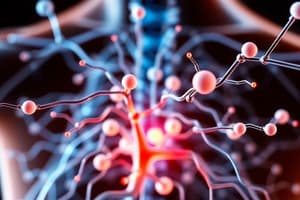Podcast
Questions and Answers
What type of axon is used by postganglionic neurons?
What type of axon is used by postganglionic neurons?
- Class B axon
- Class A axon
- Class C axon (correct)
- Class D axon
Which type of adrenergic receptor is primarily involved in the excitation of cardiac muscle cells?
Which type of adrenergic receptor is primarily involved in the excitation of cardiac muscle cells?
- Beta 1 (correct)
- Beta 2
- Alpha 1
- Alpha 2
In which area are nicotinic receptors located?
In which area are nicotinic receptors located?
- Only in sweat glands
- Only on cardiac muscle cells
- Only on postganglionic neurons
- All postganglionic neurons in sympathetic and parasympathetic systems (correct)
Which of the following neurotransmitters is released by all neurons in the parasympathetic nervous system?
Which of the following neurotransmitters is released by all neurons in the parasympathetic nervous system?
What is the primary effect of binding norepinephrine to alpha 2 receptors?
What is the primary effect of binding norepinephrine to alpha 2 receptors?
Which nerve plexus is responsible for innervating the lower limbs?
Which nerve plexus is responsible for innervating the lower limbs?
What effect does binding epinephrine to beta 2 receptors in smooth muscle cells generally cause?
What effect does binding epinephrine to beta 2 receptors in smooth muscle cells generally cause?
Which type of receptor is responsible for binding acetylcholine in muscle and gland cells stimulated by the parasympathetic division?
Which type of receptor is responsible for binding acetylcholine in muscle and gland cells stimulated by the parasympathetic division?
Flashcards
Preganglionic neurons
Preganglionic neurons
Nerve fibers that carry signals from the central nervous system (CNS) to autonomic ganglia, where they synapse with postganglionic neurons.
Postganglionic neurons
Postganglionic neurons
Nerve fibers that carry signals from autonomic ganglia to target organs.
Neurotransmitters
Neurotransmitters
Chemical messengers that transmit signals between neurons.
Acetylcholine (Ach)
Acetylcholine (Ach)
Signup and view all the flashcards
Norepinephrine (NE)
Norepinephrine (NE)
Signup and view all the flashcards
Cholinergic receptors
Cholinergic receptors
Signup and view all the flashcards
Nicotinic receptors
Nicotinic receptors
Signup and view all the flashcards
Muscarinic receptors
Muscarinic receptors
Signup and view all the flashcards
Study Notes
Autonomic Nervous System Overview
- Preganglionic neurons use class B axons to transmit signals from the CNS, synapsing with postganglionic neurons.
- Postganglionic neurons use class C axons.
Neurotransmitters
- Acetylcholine (ACh) is the neurotransmitter released by all parasympathetic neurons.
- Norepinephrine (NE) is the primary neurotransmitter of the sympathetic nervous system (fight-or-flight response).
Receptors
-
Cholinergic receptors: bind to acetylcholine.
- Nicotinic receptors: Found on all postganglionic neurons in both sympathetic and parasympathetic systems, the adrenal medulla, and skeletal muscle.
- Muscarinic receptors: Found on muscles and glands innervated by the parasympathetic division, as well as sweat glands and some blood vessels.
-
Adrenergic receptors: bind to norepinephrine and epinephrine (adrenaline).
- Alpha receptors: Found on most cells, except cardiac muscle cells.
- Alpha 1: Binding with NE leads to excitation.
- Alpha 2: Binding with NE leads to inhibition.
- Beta receptors: Found on cardiac, smooth, and skeletal muscle cells, as well as in the liver, kidneys, and adipose tissue.
- Beta 1: Found in cardiac muscle, liver, and kidney cells; binding with epinephrine (E) leads to excitation.
- Beta 2: Found in smooth muscle of blood vessels in the heart and skeletal muscles; binding with epinephrine leads to relaxation and inhibition.
- Beta 3: Found on adipocytes; binding with epinephrine leads to excitation, stimulating lipolysis.
- Alpha receptors: Found on most cells, except cardiac muscle cells.
Nerve Plexuses
- Brachial plexus: Innervates the upper limbs.
- Sacral plexus: Innervates the lower limbs and some hip structures.
- Ventral rami combine to form nerve plexuses, from which peripheral nerves branch.
Studying That Suits You
Use AI to generate personalized quizzes and flashcards to suit your learning preferences.




